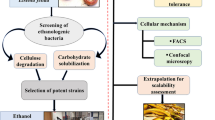Abstract
Biodegradation of lignocellulosic waste by Aspergillus terreus is reported for the first time. This isolate produced 250 CMCase (carboxymethyl cellulase or endoglucanase) U.ml-1 and biodegraded hay and straw during 3 days and the biomass production on straw was 5g.L-1dry weight from 0.25 cm2 inoculated mycellium. This strain secreted endocellulases and exocellulases in the culture medium, but some of the enzymes produced, remained cell membrane bound. Cell bound enzymes were released by various treatments. The highest amount of endoglucanase and exoglucanase was released when the cells were treated with sonication. Aspergillus terreus was added to two tanks containing sugar wastewater and pulp manufacturing waste, as a seed for COD removal. This fungus reduced the COD by 40–80 percent, also, ammonia was reduced from 14.5 mM to 5.6 mM in sugar beet wastewater. The effects of crude enzyme of this fungus for COD removal was studied.
Similar content being viewed by others
References
Akamatsu Y, Higuchi MD & Shimada M (1990) A novel enzymatic decarboxylation of oxalic acid by the lignin peroxidase system of white-rot fungus Phanerochaete chrysosporium. FEBS. Lett. 20: 261–263
Agematu H, Nakashima T, Shibamoto N, Yoshioka T, Shin T & Murao S (1994) Colorimetric measurment of total activity of leucine aminopeptidase and arylamidase in serum using laccasecatalyzed oxidative decarboxylation. Journal Ferment. Bioengin. 77: 479–482
Beldman G, Van Leeuwen S, Rombouts M & Voragen G (1985) The cellulase of Trichoderma viride purification characterization and comparsion of all detectable endoglucanases, exoglucanases and B-glucosidases. EJB. 84: 301–307
Bradford MM (1976) A rapid sensitive method for the quantitation of microgram quantities of protein utilizing the principle of protein dye binding. Anal. Biochem. 144: 142–146
Chahal DS (1994) Biological disposal of lignocellulosic wastes and alleviation of their toxic effluents. In: Chaudhry GR (ed) Biological degradation and Bioremediation of toxicchemicals (pp 364–373). Chapman and Hall, London
Christov LP, Szakacs G & Balakrishnan H (1999) Production, partial characterization and use of fungal cellulase free xylanases in pulp beleaching process. Biochemistry. 34: 511–517
Cowan WD (1996) Animal feed. In: Goldfrey T and West S (eds) Industrial Enzymology (pp 71–86). Macmillan, London
Dezotti M, Innocentini M, Lucia H & Duran N (1995) Silica immobilized enzyme catalyzed removal of chlorolignins from eucclyptus kraft effluent. Journal of Biotechnology. 43: 161–167
Emtiazi G, Nahvi I & Salehbaig M (1999) Production of cellulase (exoglucanse) by fungi in different media. Research Bulletin of Isfahan University 1: 15–28
Emtiazi G (2000) Decolorization and biodegradation of dyes by Aspergillus terreus grown on wheat straw with Mn peroxidase activity. Poll. Res. 19: 31–350
Habibi MH, Emtiazi G & Salehbeig M (1998) Decolorization and biodegradation of textile dyes. In: 14th FAOBMB symposium in Malaysia, Kuala-lampur, Malaysia. 77
Itavara M, Siika-aho M & Vilkari L (1999) Enzymatic degradation of cellulose based materials. J. Environ. Poly. Deg. 7: 67–73
Johansson T & Nyman PO (1993) Isoenzymes of lignin peroxidase and manganese peroxidase from the white-rot Basidiomycete. Arch. Biochem. Biophys. 300: 49–56
Mandel M & Weber J (1969) Exoglucanase activity by microorganisms. Adv. Chem. 95: 391–414
Okada G (1974) β-glucosidase activity in microorganisms. Biochem. J. 77: 33–42
Orth AB, Pease EA & Tien M (1994) Properties of lignin-degrading peroxidases and their use in bioremediation. In: Chaudhry GR (ed) Biological degradation and bioremediation of toxic Chemicals (pp 345–355). Chapman and Hall, London
Vares T, Kalsi M & Hatakka A (1995) Lignin peroxidases, manganese Peroxidases, and other ligninolytic enzymes produced by Phlebia radiata during solid-state fermentation of wheat straw. Appl. Environ. Microbiol. 61: 3515–3520
Winter J & Cooney C (1980) Fermentation of cellulose and fatty acids with enrichments from sewage sludge. Europ. J. Appl. Microbiol. Biotechnol. 11: 60–66
Yazdi MT, Woodward G & Radford A (1990) Cellulase Production by Neurospora crassa: The enzymes of the complex and their regulation. Enzyme Microb. Technol. 12: 116–119
Author information
Authors and Affiliations
Corresponding author
Rights and permissions
About this article
Cite this article
Emtiazi, G., Naghavi, N. & Bordbar, A. Biodegradation of lignocellulosic waste by Aspergillus terreus . Biodegradation 12, 257–261 (2001). https://doi.org/10.1023/A:1013155621336
Issue Date:
DOI: https://doi.org/10.1023/A:1013155621336




